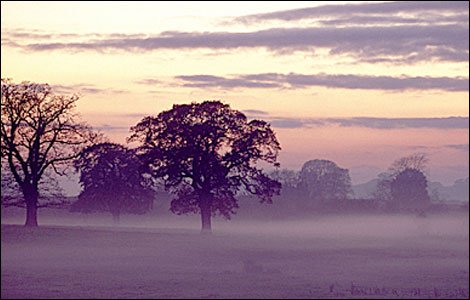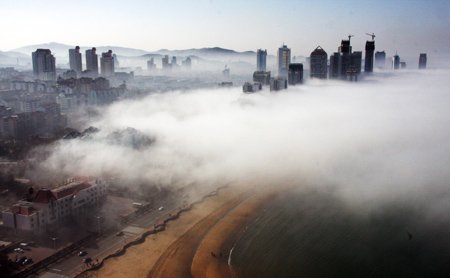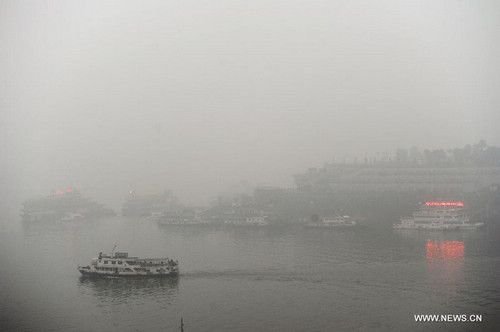Everyday Geography #8 Different types of fog and mist
I assume most of you are familiar with the natural phenomenon of fog and mist. It is the condensation of water near the surface so that a thick opaque cloud forms. As it might seem that all fog is the same, there are actually quite a lot of ways this condensation can occur. So next time you take your bike in the morning, or just watch outside your window, try to identify what caused today's fog.
In English there are two words to describe this phenomenon, being fog and mist. The main differentiation is the reduction in visibility that is caused by the occurrence, but the principals are for both terms the same. Therefor the term "fog" will be mainly used in this article.
Basic concept of fog
As mentioned before, fog is the condensation of water in the air. Warm air can hold more water vapor than cold air. When warm air containing a lot of moisture cools down to its dewpoint (Temperature when relative humidity is , it can no longer carry all the water molecules and condensation occurs. Clouds are typically formed when warm air rises and expands due to lower atmospheric pressure, making the air cool down and causes water vapor to condense. What differentiates fog from clouds is its presence near the surface due to other air cooling processes.
Radiation fog
A very common type of fog is radiation fog. This type of fog occurs during cold nights with an open sky in the winter or fall, and when the atmosphere is stable (no significant wind and temperatures higher when you go up so no rising occurs). The earth loses heat at a constant rate determined by the planck's law of black body radiation. this loss of heat will cause the lowest layer of the atmosphere to cool as well, making it possible for water to condense. Since there is no wind mixing the different layers near the surface, fog can maintain its position and can expand laterally as the air cools further. As soon as the sun rises, the surface of the earth will heat again, causing the fog to dissolve.
Radiation fog on a cold morning. Source
Advection fog
Advection fog occurs when moist air moves over an already cold surface and cools down to its dewpoint. This for example happens when warm moist sea air blows over a cold continental surface. Again an inversion of atmospheric temperature (lower temperature at the surface than above) must occur to keep the fog from dissolving.
For advection fog to disperse, either the wind direction has to change, the cool surface has to be heated, or the air has to lose its moisture.
A big difference with radiation fog is that advective fog can occur over sea too, whereas the sea surface will not cool significantly to form radiation fog due to its high heat carrying capacity.
Advection fog in the Chinese city of Yantai. Source
Precipitation fog
When rain enters a drier package of air near the surface the droplets can evaporate into water vapor. This evaporation process subtracts energy from the air causing it to cool. This cooling of the air can then cause the evaporated droplets to condense into a thick fog.
Precipitation fog in the Chongqing Municipality of southwest China. Source
Fog by air mixture
The amount of fog that air can hold is not linear with the temperature, but has a gradient as in the following graph. Every combination of air and water that is on the right side of the graph is stable, any combination on the left side will cause condensation since the amount of water is then higher than the carrying capacity of air. This means that two packages of air can be completely stable with their amount of moisture, but when mixed, the result is situated on the right side of the graph, causing condensation and fog.
Graph showing the water holding capacity of air with the mixture of two air masses. Source
Summary
So these are the main reasons fogs form, they are all related to the reduction of the decrease of water carrying capacity in the air, but how this capacity in decreased can vary from cooling to mixing. You should definitely try to identify fog when you see it, most of the times the reasons are obvious when it all occurs in front of you.
Next time you see fog, I hope you will no longer see just a cloud hanging over the surface, but the fascinating natural and physical phenomenon!
Everyday Geography: previous posts
Everyday Geography #7 Tracing back common city patterns: radial and circular city pattern
Everyday Geography #6 Tracing back common city patterns: Grid plan
Everyday Geography #5 Recognize your weather pattern
Everyday Geography #4 Why some dry soils crack
Everyday Geography #3 What makes salt tolerating vegetation special
Everyday Geography #2 Meandering, braided and straight rivers
Everyday Geography #1 Different types of dunes
Sources
http://www.weather.gov/media/zhu/ZHU_Training_Page/fog_stuff/fog_guide/fog.pdf
https://www.experimentalaircraft.info/wx/weather-fog-1.php




Getting deep into a simple word like what you did in your post is amazing...
I like it, There are youtube channles which do that either and I always subscribe like: Nerdwriter, Vsauce, Dictionary of obscure sorrows
yeah they're great too
Thanks! Its always fun to learn about things you see almost daily. Once you read about them you never look at them the same.
@originalworks
nice explaination bro @samve
Thanks!
Nice post. I wonder where the Harmattan haze would fall under